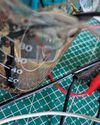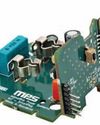Cobots Work Alongside HumAns To Do Dull, Dirty, Dangerous, Dear Jobs
Electronics For You
|September 2022
Human workers, who once saw industrial robots as a threat to their jobs, are now quite happy to share the space with the current generation of cobots, as these are proving to be truly cooperative, collaborative, and congenial co-workers

Some years ago, a hammer fell into a high-pressure steam pipe at Tata Power’s plant in Mundra, Gujarat, stalling the plant’s operations. It was a pretty complex situation, as the 90-degree bend of the pipe made it almost impossible to see where the hammer was stuck. Interestingly, the plant sought the help of Gridbots Technologies, an Ahmedabad based robotics startup. The Gridbots team made some modifications to the gripper of their Stinger pipeline robot and managed to get the hammer out in a five-hour operation, at a cost of ₹1,600,000. Compare that with all other alternatives, which would have taken several days and cost the company tens of billions of rupees in expenses and losses, and you will understand why a lot of robotics enthusiasts remember and recall this story even after so many years.
That indeed is what robots are meant to do. In the robotics world, this is known as the 4D principle—let robots do tasks that are dull, dirty, dangerous, or dear. That is, work that is repetitive, unhygienic, risky, or costly (where one cannot afford to err). For this purpose, robots have been used in heavy industries like automotive, and dangerous conditions like mines, for a long time now.
However, the robots of yore were generally expensive, huge, heavy, and often dangerous. They had to be confined to work-cells, away from human workers. Most robots were also difficult to program, and hence used for specific, unchanging tasks. This put them out of the reach of small and medium sized industries characterised by high-mix, low-volume jobs. On top of everything else, human workers often looked at these intimidating robots as the bad guys who had come to steal their lunch!
Enter cobots
このストーリーは、Electronics For You の September 2022 版からのものです。
Magzter GOLD を購読すると、厳選された何千ものプレミアム記事や、10,000 以上の雑誌や新聞にアクセスできます。
すでに購読者ですか? サインイン
Electronics For You からのその他のストーリー

Electronics For You
Tech Majors Are Racing TOWARDS NET-ZERO - What About You?
Apple, Microsoft, Amazon, Google, Infosys, Wipro—global and Indian firms are heading closer to achieving net-zero emissions, a mandate to combat climate change. Here is what you need to know to start your journey...
12 mins
December 2025

Electronics For You
Miniature IoT WATER TDS And LEVEL MONITOR Cum CONTROLLER
For setups that rely on stored water, clear awareness of tank level and water quality is essential.
3 mins
December 2025

Electronics For You
The Impact Of GENERATIVE AI On The Future Of AUTOMOTIVE AND EVs
Autonomous vehicles, connected ecosystems, and smart factories are only the beginning. Generative Al is pushing the auto industry beyond predictions into a bold era of creativity-from EV design to real-time diagnostics and showroom automation. Here is how GenAl is reshaping innovation across the automotive value chain.
8 mins
December 2025

Electronics For You
How AI Tools Are Making SOFTWARE DEVELOPMENT BETTER
AI is reshaping how we code, debug, and collaborate. From Copilot to automation, it is changing software development in ways worth exploring.
3 mins
December 2025
Electronics For You
How AI Tools Are Making SOFTWARE DEVELOPMENT BETTER
AI is reshaping how we code, debug, and collaborate. From Copilot to automation, it is changing software development in ways worth exploring.
3 mins
December 2025

Electronics For You
5 Interesting Reference Designs FOR SMART HOMES
Smart home devices are transforming the way people interact with their appliances. They make homes more convenient, secure, and energy-efficient. From smart plugs and energy monitors to smart locks and thermostats, reference designs help design engineers create connected products that are easy to use, consume less power, and are reliable. These designs allow you to control devices remotely, track energy use, extend battery life, and automate routines. They provide practical solutions for upgrading homes and small commercial spaces without major modifications.
3 mins
December 2025

Electronics For You
Fancy USB LED VASE
This USB LED vase is a simple yet elegant device that fuses art with electronics to create a decorative lighting display. Powered directly from a standard USB port, it uses readily available components such as MOSFETs, resistors, capacitors, and LEDs to produce a striking, dynamic sequence of lights.
3 mins
December 2025

Electronics For You
"WHAT OTHERS SELL IN FOUR BOXES WE BUILT IN ONE"
Years of custom field work are shaping a product line with its own cloud, its own hardware, and a market that is now beginning to recognise its value.
8 mins
December 2025

Electronics For You
BUILD LARGE LANGUAGE MODELS
Large language models are machine learning models designed for a range of language-related tasks such as text generation and translation. Here’s how open source software can help you build your own large language model.
6 mins
December 2025

Electronics For You
Rare Earth Or Rare Ingenuity? India Remains Between The Two
With China firmly controlling rare earth exports, India confronts a critical moment in its technological trajectory.
8 mins
December 2025
Translate
Change font size

